People
‘People Have Woken Up—to a Degree’: Artist Fred Wilson on Progress in the Art World and the Evolving Reception of His Work
The artist spoke with us on the occasion of his splendid exhibition at Pace gallery in New York.
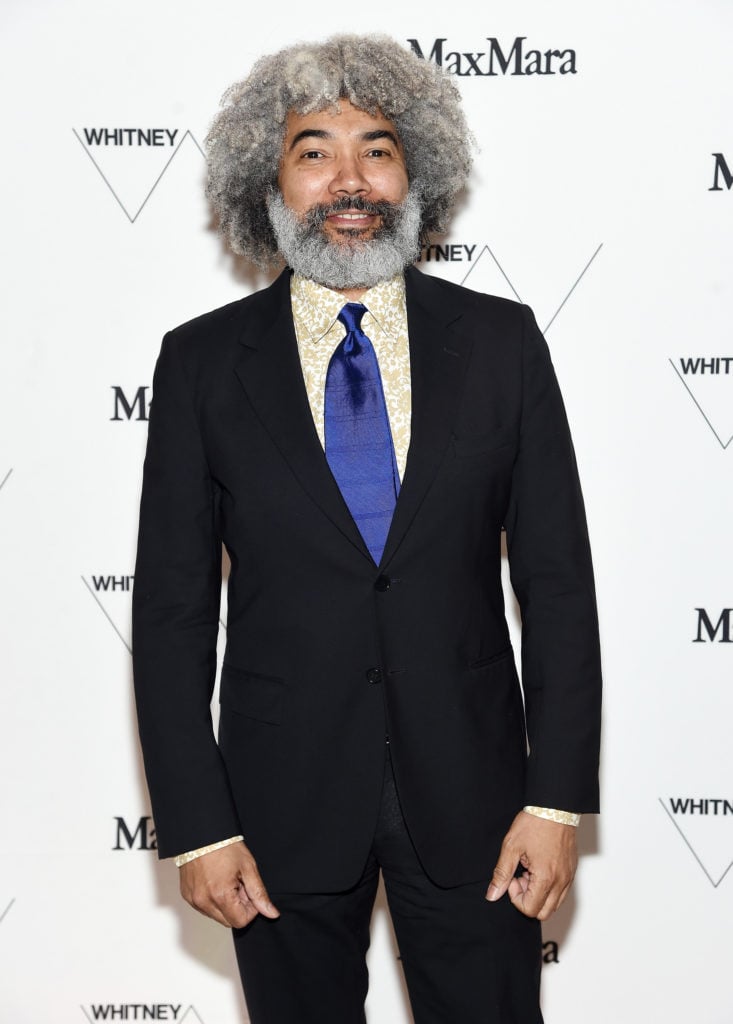
The artist spoke with us on the occasion of his splendid exhibition at Pace gallery in New York.

Terence Trouillot

For almost 20 years, conceptual artist Fred Wilson has been working with the unforgiving material of black Murano glass, creating large and exquisite chandeliers in the Venetian and Ottoman traditions, woven through with his own particular research interests.
In 2003, he showed a group of these works at the Venice Biennale, where the chandeliers implicitly explored the history of the city’s African population, who are often represented in Venetian art—but almost always as an aside, and rarely as the main focus of the work.
He expanded his interests when he presented another set of chandeliers at the 2017 Istanbul Biennial, where the works—now modeled on Ottoman design—elaborated the history of Venetian–Ottoman relations.
A group of these exquisite and sometimes foreboding works are now on view at Pace gallery’s new location in New York, taking advantage of the space’s 19 foot ceilings. On the occasion of the show, we spoke with the artist.
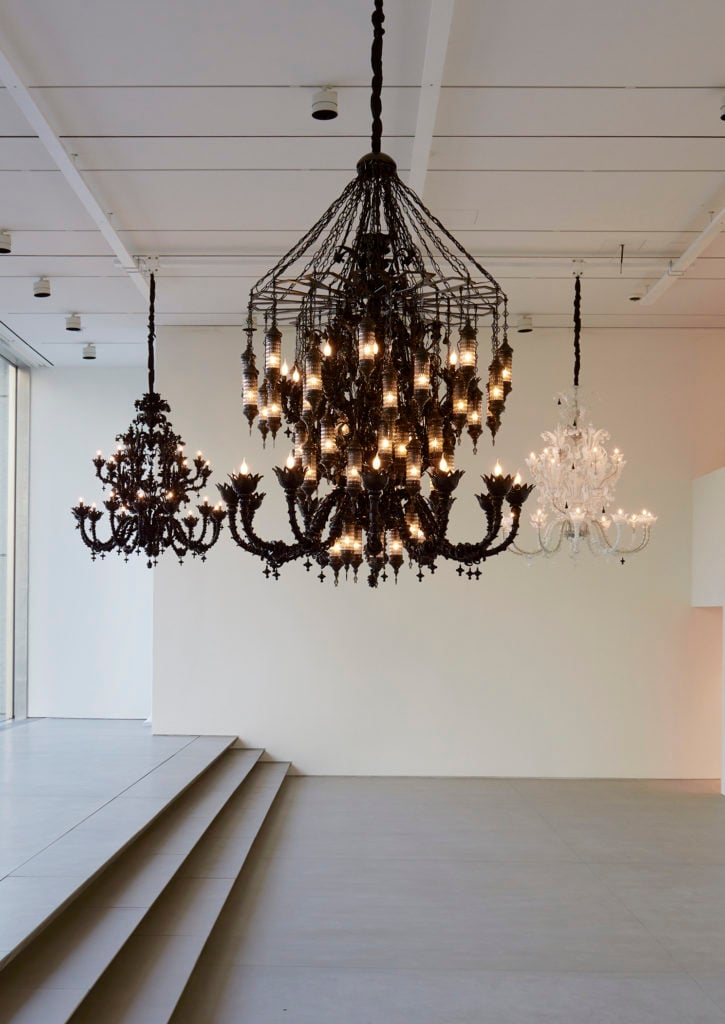
Installation view “Fred Wilson: Chandeliers” at Pace, 524 West 25th Street. Photo: Guy Ben-Ari, courtesy of Pace Gallery.
Your chandelier works first appeared at the 2003 Venice Biennale at the US pavilion, and again more recently at the 2017 Istanbul Biennal. Can you talk a little bit about the genesis of these works?
Well what happened was, in 2001, I had a residency at the Pilchuck Glass School in a beautiful rural area just outside of Seattle. I had never thought about glass before, but as a conceptual artist I said, “Well alright, you invited me, why not?” Lorna [Simpson] had done something there, Kiki [Smith] had done something there, and it seemed to be good for them. So I said, “alright, I’ll try it.” That’s really when I started working in glass, and the first thing was this drip form that I would put on walls. And I had this gaffer—the person who blows the glass—and he’s a spectacular glass artist, who really enjoyed making these shapes for me, and we got along and worked very well together.
That’s the backdrop of how I really thought about working with glass and with other artists, or artisans or craftsmen. And on the heels of that I got into the 2003 Venice Biennale. But you know, the [chandelier works] come in a million parts. They’re really heavy, and they’re never in one place. I’ve never had one in my studio because they are so big. I go to Italy to work on them, and then they come back here and go straight to Pace, they don’t come to me. And that’s because they’re so laborious to put together. So it will be nice to see them all together. That’s the exciting thing for me.
And you went to Venice prior to this to do research?
Oh, yeah. On the heels of this burgeoning glass thing, I go to Venice and what do I see? Chandeliers. I see chandeliers everywhere. And at time, I was thinking a lot about Venice, looking at the paintings in the [Gallerie dell’Accademia] and elsewhere, and there’s all these Africans in all these paintings. They knew who everyone else was in the paintings, but they didn’t know who these black people were, not a clue.
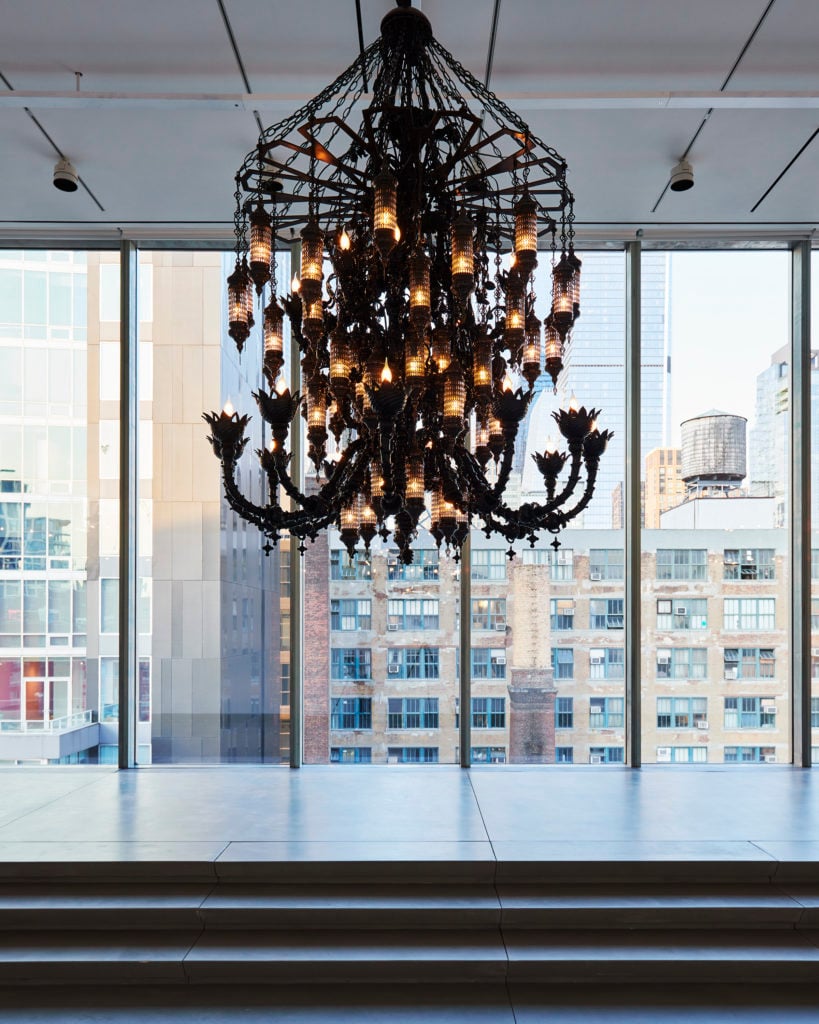
Installation view “Fred Wilson: Chandeliers” at Pace, 524 West 25th Street. Photo: Guy Ben-Ari, courtesy of Pace Gallery.
And you conducted a lot of research to find out the identities of those black figures.
I did. I worked with an art historian and we went around and counting all the blacks folks we saw in Venice. And there were a lot of images of black figures on door knobs. It was just crazy. In the midst of all this research, I saw these really beautiful pastel-colored images of chandeliers, and it was kind of a no-brainer for me from doing these black drips. And I use black for obvious reasons. But I’m also interested in all the meanings that are comprised in that color. And in Venice, black glass is something you don’t see very often and certainly not in chandeliers.
Do you want to continue making chandelier works?
I do have this one idea and maybe it’ll go somewhere or maybe this will be my Swan Song with chandeliers, I don’t know. We’ll see. But you know, I don’t set out to make beautiful things. I mean I like the Venetian chandelier form, and I like the Ottoman form, but I’m more concerned about the history and meaning behind these objects.
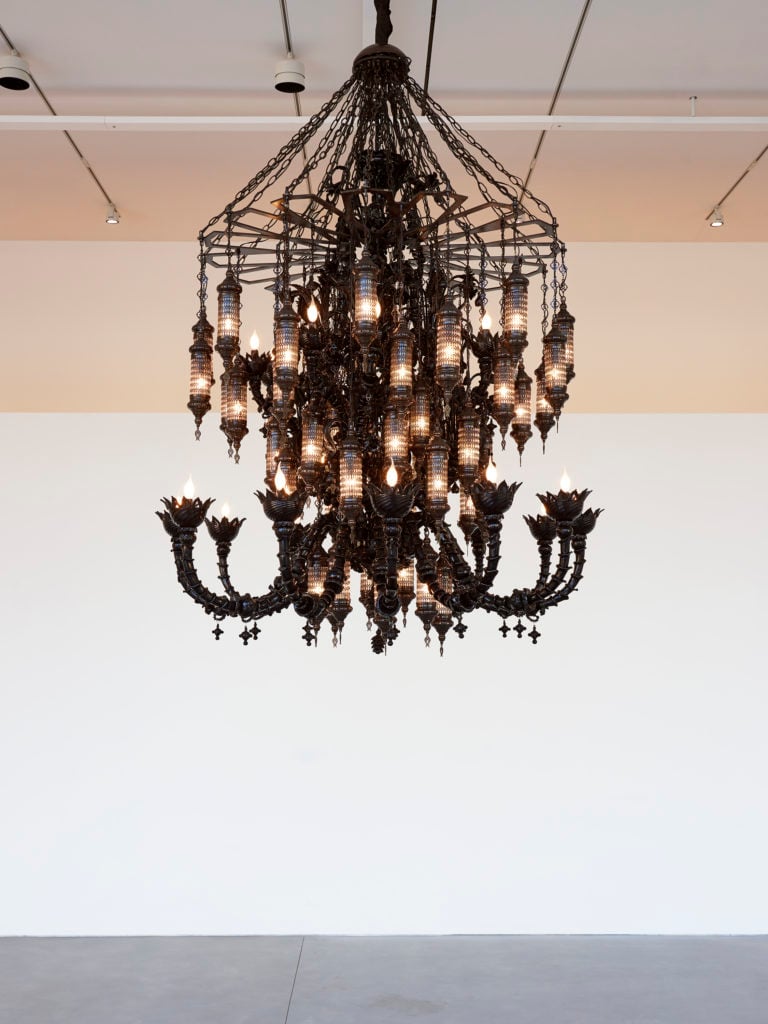
Installation view “Fred Wilson: Chandeliers” at Pace, 524 West 25th Street. Photo: Guy Ben-Ari, courtesy of Pace Gallery.
That’s interesting because you pay so much attention to the materials and artistry of these works, even though I’ve always considered you an artist who works with existing objects, rather than one who makes new ones.
I think I’m getting less and less connected to materiality. Working with hot glass, that is the high point. Whatever comes out it is beautiful, it’s great, but it’s about the experience. And it’s a very fast process. You’re manipulating it really fast, depending on what you want to make. Because it’s this hot substance that deals with gravity, and you have to keep moving it. I enjoy understanding the qualities of the material and what it can and can’t do. I’m not particularly interested in making it do something it’s not supposed to do. I prefer to work with things, just like with people, that do what they do best. I think I get a better product that way, instead of trying to force it to be something else.
I think when I was showing at galleries like Metro Pictures, I was working with things that I found, not things that I would consider I made. And I think that was largely because that’s what I had access to. I enjoy things in the world that are around us, and that we don’t really examine that much, or we don’t think about.
The Venetian glass-blowing is the same thing. It’s there. You don’t really examine it that much because it is what it is. It’s not really considered high culture anymore, but it’s high culture for some people. It is beautiful. But I always like, no matter what it is, to look beneath what it is or what it represents. And looking at the notion of luxury is also interesting to me. So that’s the connection. It’s a conceptual connection. I don’t particularly have a medium. So if I have the opportunity to do something new, I’ll try it. It has to meet my interest. But I don’t mind making art, and it wasn’t a difficult transition.
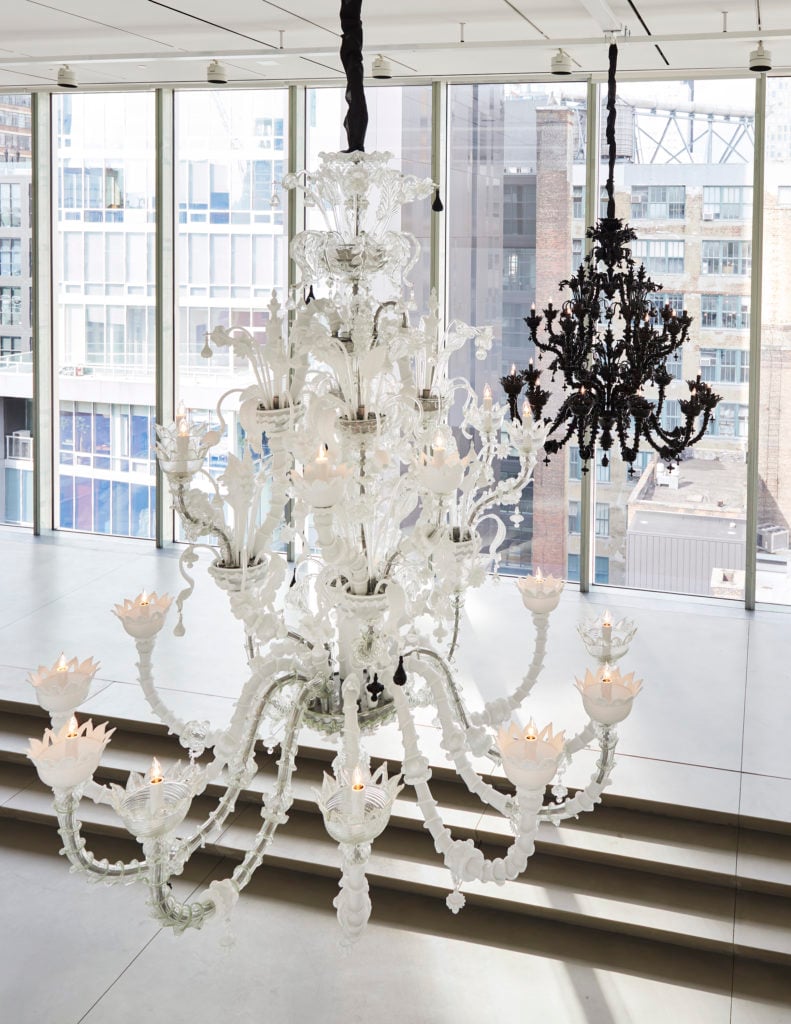
Installation view “Fred Wilson: Chandeliers” at Pace, 524 West 25th Street. Photo: Guy Ben-Ari, courtesy of Pace Gallery.
It’s funny you mention that you don’t really have a medium, because you’re known as the artist whose medium is the museum.
Yes, the museum is my medium, but I haven’t just done these museum projects. The Istanbul Biennial was basically a museum project. But the new thing I’m interested in is making objects within the context of a museum, or introducing something I make into a museum collection. But everything has to be right for something like that to develop.
I want to pivot a little and talk about reactions to your work. Some of my favorite aspects of “Mining the Museum,” your 1982 show at the Maryland Historical Society in Baltimore, were there questionnaires you had visitors fill out about their reactions to your unearthing of implicit museum biases and racisms. How important are those reactions to you?
Those questionnaires were the curator’s idea, Lisa Corrin. She’s now the director of the Block Museum at Northwestern University. And I thought that was a really good idea because you know, this is an unusual [exhibition] experience. Thinking about how people react doesn’t really inform what I do, [but] it is important to me to know the lay of the land before I do a project. In Baltimore, I did my research and spoke to the community, and tried to understand the place before committing to the project. In Istanbul, I went seven times, like every month, and even afterwards I was concerned that I made a misstep. But I wouldn’t have done it if I didn’t take the time to understand certain aspects of the culture.
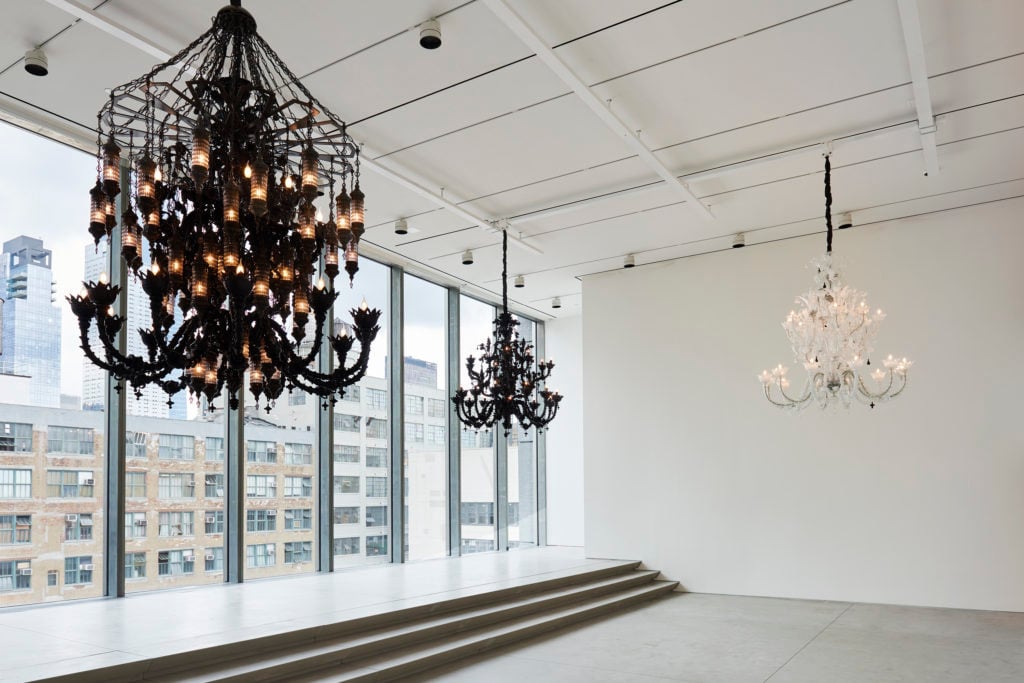
Installation view “Fred Wilson: Chandeliers” at Pace, 524 West 25th Street. Photo: Guy Ben-Ari, courtesy of Pace Gallery.
I know you’re interested in inserting objects into museum collections, and there’s an element of trickery there, where you’re surreptitiously giving off the impression that some of works are existing artifacts. In fact, you’re fooling the audience. Do you imagine yourself as a kind of provocateur in that sense?
I don’t really think of myself that way. I see the denial and I just reveal it because it’s there. There’s a very thin covering over it, so the removal of one thing or the addition one thing can really inform the experience. I want people to reflect—to be self-reflective—more than anything else. I think sometimes the reaction is shock. But what I’m looking for, more than anything, is a kind of personal meditation on people’s view of the world.
A few years ago, I heard you speak at the Brooklyn Museum, and you spoke candidly about working as a museum educator and how, at the time, it was one of the only ways for African Americans to get work in the art world. Have you noticed any changes in museums or the art world since?
It was really different [and these two] very different communities didn’t understand [one] another [back then. But] it’s fantastic what’s happening now for younger black artists. I think at one time, the inclusions of black artists in museum shows [led to] knee jerk reactions. You know “ this just puts a Band-Aid on [a bigger issue].” But now things are very different. I think there is a lot more that needs to be done, but I feel generally people have woken up—to a degree.